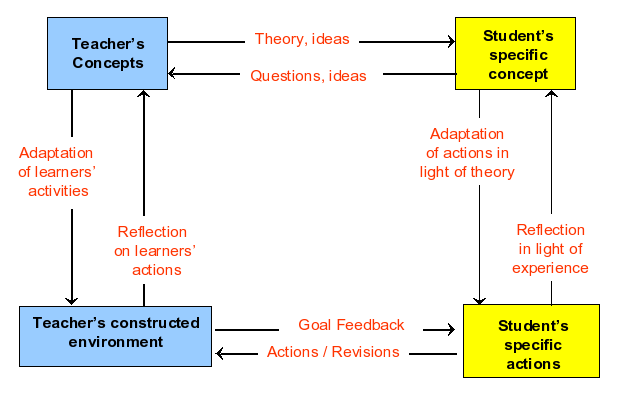Laurillard conversational framework
Definition
Laurillard (1993,2002) claims that there are four main aspects of the teaching-learning process and that different educational media can be analyzed (and used) in terms of these dimensions.
This framework can be considered both learning theory and a practical framework for designing educational environments. Higher education, according to Laurrillard is much about acquiring "ways of seeing the world". Associated pedagogic strategy has to consider different forms of communication and associated mental activities: Discussion, adaptation, interaction, reflection.
See also guided discovery learning
Design of learning environments
Laurillards framework includes for important components:
- Teacher's concepts
- Teacher's constructed learning environment
- Student's concepts
- Student's specific actions (related to learning tasks).
Each (larger) pedagogical scenario should include all four kinds of activities (communication forms) that happend in 8 kinds of "flows" in the model.
- (1) Discussion
- between the teacher and the learner
- Teachers' and learners' conception should be mututally accessible
- Both should agree on learning objectives
- (2) Adaptation
- of the learners actions and of the teacher's constructed environment.
- Teacher must adapt objectives with regards to existing conceptions
- Learners must integrate feedback and link it to his own conceptions
- (3) Interaction
- between the learner and the environment defined by the teacher
- Teacher must "adapt to world", i.e. create an environment adapted to the learning task given to the learner
- Teacher must focus on support for task and give appropriate feedback to the learner.
- (4) Reflection
- of the learner's performance by both teacher and learner
- Teacher should support the learner to revise his conceptions and to adapt the task to learning needs
- Learners should reflect with all stages of the learning process (initial concepts, tasks, objectives, feedback, ...)
Media and activities
According to Philipps (1988), “Laurillard argues that the only use of technology which can meet these aims is the "multimedia tutorial simulation", characterised in terms of guided discovery learning. Her schema is based on forming an information rich environment in which the student has control in discovering knowledge, but the discovery is supported and scaffolded by extra guidance functions (Laurillard, 1993) which provide support and feedback for subsequent learning. These functions are analogous to the coaching and scaffolding at critical times proposed in the Situated Cognition Theory.”
- to be written, show that different media-supported scenarios are different and maybe that different media have different affordances
Laurillard argues that different media forms support different learning experiences. She identifies five media forms: narrative, interactive, communicative, adaptive and productive.
Links
- A conversational framework for Instruction (nice chart)
- Diana Laurillard's conversational model Part of a GLOW text on What educational theories apply to web-based learning?
References
- Atherton J S (2005) Learning and Teaching: Conversational learning theory; Pask and Laurillard [On-line] UK: Available: http://www.learningandteaching.info/learning/pask.htm Accessed: 12 September 2006
Crawley, R.M., Evaluating CSCL - Theorists' & Users' Perspectives, JISC Technology Applications Programme (JTAP), HTML, retrieved 19:05, 22 November 2006 (MET).
- Laurillard, D. (1992). Learning through collaborative computer simulations. British Journal of Educational Technology, 23, 164-171.
- Laurillard, D. M. (1993). Rethinking University Teaching: A Framework for the Effective Use of Educational Technology. Routledge, London.
- Laurillard, D. (2002). Rethinking University Teaching. A conversational framework for the effective use of learning technologies. London: Routledge ISBN 0415256798 .
- Philipps, Rob, (1998), Models of learning appropriate to educational applications of information technology, Paper presented at the 1998 Teaching and Learning Forum, held at the University of Western Australia. HTML, retrieved, 17:17, 15 September 2006 (MEST).
- Phillips, R. (1997). The Developer's Handbook to Interactive Multimedia - A Practical Guide for Educational Applications. Kogan Page, London.
